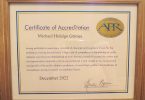The First of Two Steps in the APR Examination Process
Over the past two years, the Universal Accreditation Board (UAB) invested considerable time in updating the computer-based Examination (CBE) for Accreditation in Public Relations. The fruit of this labor was the launch of the updated 2016 Examination, which is the second step in a two-part Examination process. The first step in the process was known previously as the Readiness Review. It now is called the Panel Presentation.
Just as the UAB went through a rigorous analysis of research on attitudes about the Examination, it also reviewed research relative to perceptions about the Panel Presentation, outcome data on Panel Presentation candidates who were Advanced but did not pass the CBE, the OPG report and other data to determine if and how the Panel Presentation should be modified and updated. The UAB looked at the areas of knowledge, skills and abilities (KSAs) being tested; the logistics; the questionnaire; the role of the panelists; its purpose and its name.
Let’s start with the purpose.
The Panel Presentation was designed to evaluate 16 KSAs, which were determined as untestable on the CBE. Following the submission of a detailed written communications plan, the candidate would deliver a live presentation to a three-member panel of Accredited professionals who would assess and score the candidate’s portfolio, presentation skills and other KSAs. Additionally, the panel would determine whether the candidate was sufficiently prepared to sit for and pass the CBE. If the scores met a predetermined threshold and the panelists were in accord on the candidate’s readiness to sit for the CBE, the candidate would be Advanced.
However, as data showed that Advancement from the Panel Presentation was not an accurate indicator of a candidate’s ability to pass the CBE, the UAB removed the “readiness” descriptor entirely. This first step now simply evaluates the KSAs that the computer-based Examination cannot effectively evaluate.
The role of the panelists themselves was another area for review. Many of our resources stressed that the panelists need to provide mentoring to candidates who may demonstrate deficiencies in certain areas of practice or preparation, and help them determine an appropriate course of study to prepare for the CBE. While mentorship certainly is encouraged and will only help the candidates, the reality is that most panelists are convened for the purpose of reviewing one or more candidate’s questionnaire — a very long and detailed questionnaire — and then participating in a two-hour presentation. Making an additional commitment to mentor candidates is optional for the panelists and something that a Chapter Accreditation chair or participating organization’s APR designee can coordinate with other local professionals if needed. The onus to mentor does not fall on the panelist.
The logistics of delivering one’s Panel Presentation also have relaxed slightly. Previously, it was required that the Panel Presentation be conducted in person. Exceptions could be made by the Eligibility and Appeals work group for extreme hardships such as for international candidates, those deployed in military service overseas, candidates with physical disabilities or an Accreditation chair’s inability to recruit three panelists into the same venue. Given advancements in technology and the ease of availability of teleconferencing tools, the need to justify “hardship” has been removed. That said, all of the Panel Presentation panelists must be able to view the candidate’s presentation live. Recorded presentations are not allowed.
Candidates should be advised that technology is not an equal substitute for an in-person interaction; and the finer nuances of one’s verbal and nonverbal presentation skills can be lost in transmission and ultimately impact one’s rating. (Similarly, reliance on computer-generated tools like PowerPoint for one’s presentation also can impact a presentation in the event of technological failure. Candidates are encouraged to have a contingency plan.) The decision to allow for a synchronous, virtual Panel Presentation will be made by the local Accreditation chair.
As for the 16 KSAs previously evaluated during the Panel Presentation, four were determined to be adequately covered by questions on the 2016 Examination, so they have been removed from the score card. The four include:
- Client/employer/organizational focus. This one is assessed in the CBE KSAs and related learning objectives 5.1 (business literacy) and 5.3 (organizational structure and resources). Those questions evaluate, among other things, a candidate’s understanding of how employers and clients generate review and how their operations are conducted; how the PR function contributed to the financial success of the organization; how organizations are structured; and which divisions need to be involved in a communications program.
- Teaches others. This KSA is assessed in learning objective 5.5 (leadership skills), which evaluates a candidate’s understanding of motivation, influence and inspiration; achieving goals; building coalitions; and communicating vision.
- Control analysis. This KSA is assessed in learning objectives 1.3 (analytical skills) and 1.4 (strategic thinking), which test a candidate’s ability to analyze the business environment, interpret data and synthesize relevant information to determine what is needed to best position the client, organization or issue appropriately.
- Communication skills / interviewing. This KSA is assessed in learning objective 1.2 (research (applications)), which evaluates a candidate’s ability to use research tools to gather information about the client, industry or relevant issues; investigate the stakeholders’ understanding of the product; and apply research findings.
Another area of the Panel Presentation process that was updated was the third section on the questionnaire. The first question in this section referenced a candidate’s readiness to sit for the CBE, which as previously stated, no longer is part of the Panel Presentation assessment, so it has been removed. The remaining two questions have been rolled, unchanged, into the first section of the questionnaire.
Last, but certainly not least, is the new name, which you know now is the Panel Presentation. This first step in the Examination process focuses heavily on an assessment of the candidate’s presentation skills as demonstrated by their portfolio presentation — written, verbal, nonverbal, listening and interpersonal skills. A candidate’s understanding of the four-part process is a critical precursor to creating the presentation itself, but not the primary focus of this assessment. (Mastery of the four-part process is thoroughly covered on the CBE.) Including the word “panel” distinguishes this step significantly from the computer-based portion of the Examination process and provides clarity to the entire process.
These changes to the Panel Presentation will go into effect Jan. 1, 2017, and will not impact any candidates sitting for their panels prior to then.
Kathleen M. Giery, APR, CPRC, is the chair of the Universal Accreditation Board Examination Workgroup. She can be contacted at gieryk@lifequest.ufl.edu.








Hello: Thank you for sharing this update to the APR process. Over the years, I served on five Readiness Review panels (now of course, known as Panel Presentations) and found most candidates were well prepared, however some candidates — and panelists — were not fully cognizant of the need for an in-person presentation. Like the public relations profession, the Accreditation process needs to evolve to remain relevant and retain its value for candidates and those serving on the panel. Bravo to the UAB for keeping the program moving forward.